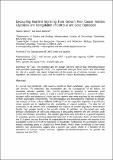Decoupling nutrient signaling from growth rate causes aerobic glycolysis and deregulation of cell size and gene expression
Author(s)
Botstein, David; Slavov, Nikolai G
DownloadSlavov-2012-Decoupling Nutrient.pdf (636.6Kb)
PUBLISHER_POLICY
Publisher Policy
Article is made available in accordance with the publisher's policy and may be subject to US copyright law. Please refer to the publisher's site for terms of use.
Terms of use
Metadata
Show full item recordAbstract
To survive and proliferate, cells need to coordinate their metabolism, gene expression, and cell division. To understand this coordination and the consequences of its failure, we uncoupled biomass synthesis from nutrient signaling by growing, in chemostats, yeast auxotrophs for histidine, lysine, or uracil in excess of natural nutrients (i.e., sources of carbon, nitrogen, sulfur, and phosphorus), such that their growth rates (GRs) were regulated by the availability of their auxotrophic requirements. The physiological and transcriptional responses to GR changes of these cultures differed markedly from the respective responses of prototrophs whose growth-rate is regulated by the availability of natural nutrients. The data for all auxotrophs at all GRs recapitulated the features of aerobic glycolysis, fermentation despite high oxygen levels in the growth media. In addition, we discovered wide bimodal distributions of cell sizes, indicating a decoupling between the cell division cycle (CDC) and biomass production. The aerobic glycolysis was reflected in a general signature of anaerobic growth, including substantial reduction in the expression levels of mitochondrial and tricarboxylic acid genes. We also found that the magnitude of the transcriptional growth-rate response (GRR) in the auxotrophs is only 40–50% of the magnitude in prototrophs. Furthermore, the auxotrophic cultures express autophagy genes at substantially lower levels, which likely contributes to their lower viability. Our observations suggest that a GR signal, which is a function of the abundance of essential natural nutrients, regulates fermentation/respiration, the GRR, and the CDC.
Date issued
2012-11Department
MIT Materials Research Laboratory; Massachusetts Institute of Technology. Department of Biology; Massachusetts Institute of Technology. Department of PhysicsJournal
Molecular Biology of the Cell
Publisher
American Society for Cell Biology
Citation
Slavov, N., and D. Botstein. Decoupling Nutrient Signaling from Growth Rate Causes Aerobic Glycolysis and Deregulation of Cell Size and Gene Expression. Molecular Biology of the Cell 24, no. 2 (January 10, 2013): 157-168.
Version: Final published version
ISSN
1059-1524
1939-4586